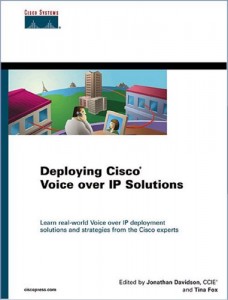
Deploying Cisco Voice Over IP Solutions
This book is a sequel to Voice over IP Fundamentals, published by Cisco Press in
2000. Since the publication of that book, there has been a fundamental change in
the assumptions made by those in the telecommunications industry. Instead of
incumbent telecommunications service providers attempting to determine whether
packet voice will be a viable technology, they are attempting to determine the right
opportunity to begin deploying this technology. These providers are either actively
researching the technology, conducting lab trials, or deploying it. In addition,
existing TDM equipment providers have determined that they must provide packet
voice equipment in addition to their TDM equipment. These equipment providers are
forced down this path due to the fact that their customers want and need to
purchase this type of equipment.
The next phase of packet voice will focus not just on lowering equipment costs
(capital expenditures), but lowering operating expenditures. This phase will be
completed over time by integrating voice technology into Network Management
Systems (NMS) owned by incumbent carriers as well as integrating IP data NMS
technology and packet voice network management systems.
Although service providers realize that there are many benefits to packet voice
technology, they also recognize that there are potential downsides to this
technology. The largest of the potential caveats is multi-vendor equipment
interoperability. Although there are many standards defining how devices should
communicate with each other, there are few standards defining how these
independent standards should communicate with each other. One example is how
many existing networks utilize H.323 to signal voice calls over IP. There are several
newer protocols, however, that appear to have momentum in this space—MGCP,
MEGACO, and SIP, for example.
The good news about protocol interworking is that there is much work being done in
this space. Each major protocol has its own interoperability event at least yearly.
There is a good analogy that can be drawn from the data networking industry. There
are dozens of routing protocols currently in use across the world for routing IP across
heterogeneous networks (OSPF, IS-IS, BGP, EIGRP, and so on), and all of these
protocols must interoperate with one another in order for IP networks to be truly
ubiquitous. This interoperability has, of course, been accomplished. Another
comparison that can be drawn between packet voice signaling protocols and IP
routing protocols is that there is a definite need for each of these protocols in certain
types of networks, and one cannot expect to erase the need for another. In the
packet voice space, a newer protocol such as MEGACO may be better for certain
applications, but it doesn’t solve the same problem that protocols such as H.323
solve. Therefore, they are both necessary, and interoperability between the two is
required.
The interoperability between equipment vendors will be solved, and then the next
level of interoperability will bubble to the surface—that of service interoperability, or
how users can utilize a similar application across an entire service area in a similar
manner.